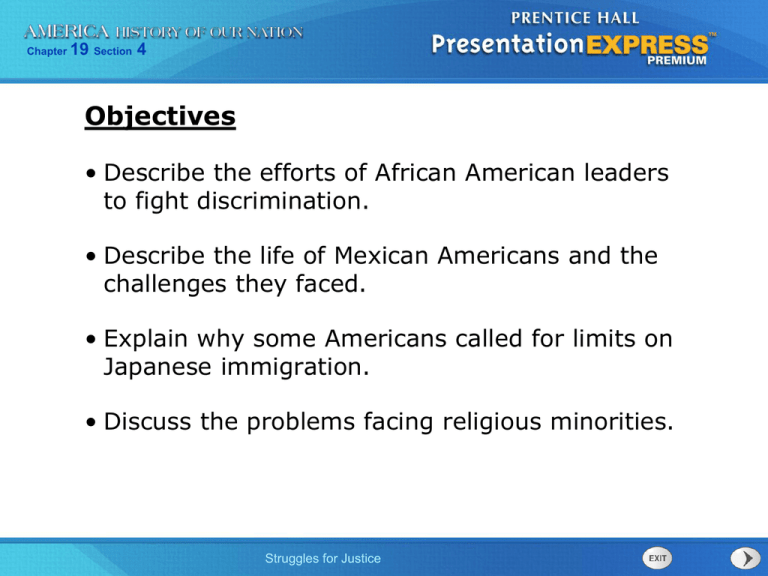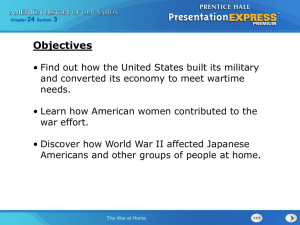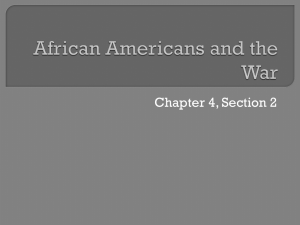AHON_ch19_S4 - Epiphany Catholic School
advertisement

Chapter 19 Section 4 Objectives • Describe the efforts of African American leaders to fight discrimination. • Describe the life of Mexican Americans and the challenges they faced. • Explain why some Americans called for limits on Japanese immigration. • Discuss the problems facing religious minorities. Struggles for Justice Chapter 19 Section 4 Terms and People • Booker T. Washington – educator and prominent African American leader • W.E.B. Du Bois – African American leader who urged blacks to fight discrimination • lynching – murder by a mob • parochial school – school sponsored by a church • anti-Semitism – prejudice against Jews Struggles for Justice Chapter 19 Section 4 What challenges faced minority groups? Though they fought for reform, most Progressives had little interest in fighting against discrimination. The turn of the century was a time of struggle for many ethnic and religious minorities. Struggles for Justice Chapter 19 Section 4 Jim Crow laws enforced segregation. Landlords refused to offer equal housing. African Americans faced discrimination in both the North and the South. African Americans were restricted to the poorest jobs. Lynchings increased after the depression of 1893. Struggles for Justice Chapter 19 Section 4 Booker T. Washington was one of the most prominent African American leaders of the time. • Born into slavery • Helped found the Tuskegee Institute • Advised African Americans to learn trades and move up gradually in society Struggles for Justice Chapter 19 Section 4 W.E.B. Du Bois had a different view of how African Americans should respond to discrimination. • First African American to receive a Ph.D. from Harvard • Agreed with Washington on the need for education • Urged blacks to fight discrimination now Struggles for Justice Chapter 19 Section 4 Fighting against discrimination, however, was not easy. Blacks were threatened, beaten, and even lynched. The journalist Ida B. Wells used her newspaper, Free Speech, to raise awareness, despite threats against her life. She called on African Americans to: • boycott segregated streetcars • boycott white-owned stores Struggles for Justice Chapter 19 Section 4 In 1909, W.E.B. Du Bois joined Jane Addams and other reformers to create an organization to work for equal rights for African Americans. National Association for the Advancement of Colored People (NAACP) African Americans saw some successes during the Progressive Era: Sarah Walker became the first female African American millionaire. Struggles for Justice Scientist George Washington Carver discovered new uses for Southern crops. Chapter 19 Section 4 Mexican Americans were also targets of discrimination. • They were denied skilled jobs and often worked as manual laborers. • They were paid less than Anglo workers. • Their children were forced to go to separate schools. Struggles for Justice Chapter 19 Section 4 The number of Mexicans immigrating to the United States soared following a revolution in Mexico in 1910. All levels of Mexican society immigrated, mostly to the Southwest. In time, the migration spread to the Midwest and the Rocky Mountains. Struggles for Justice United States Mexicans War and famine Chapter 19 Section 4 Despite discrimination, Mexican Americans found ways to help each other. Mexican Americans created barrios to preserve their language and culture. They formed mutualistas such as the Mexican Blue Cross to help each other. The barrio in Los Angeles was the most populous. These groups collected money for insurance, legal advice, and those in need. Struggles for Justice Chapter 19 Section 4 Prejudice against Asians had already stopped Chinese from immigrating to the U.S. Chinese Exclusion Act of 1882 Employers on the West Coast began to hire Asian immigrants from other countries, such as Japan. More than 100,000 Japanese entered the United States in the early 1900s. Struggles for Justice Chapter 19 Section 4 Many Japanese immigrants farmed land that Americans had thought was useless. Japanese farms soon became profitable. Yet Anti-Japanese feelings ran high. Struggles for Justice Chapter 19 Section 4 Japanese leaders were insulted. Roosevelt wanted to avoid conflict with a growing naval power. In response to public pressure, President Roosevelt reached a “Gentlemen’s Agreement” with the Japanese government. Roosevelt convinced the Japanese to stop any more workers from entering the United States. Struggles for Justice In return, the U.S. allowed the wives of Japanese immigrants already in the county to join their husbands. Chapter 19 Section 4 Members of religious minorities also suffered discrimination. Nativist groups worked to restrict Catholics and Jews from immigrating. Catholics and Jews who were not immigrants faced discrimination in jobs and housing. Struggles for Justice Chapter 19 Section 4 Like other minorities, Catholic children were often discriminated against in school. In response, American Catholics set up their own schools. Public Schools Parochial Schools Run by states Run by churches Struggles for Justice Chapter 19 Section 4 Jews also faced serious prejudice in the legal system. One man was falsely accused of murder and lynched. To combat antiSemitism, American Jews founded an organization to promote understanding and fight prejudice. Anti-Defamation League Today, many Americans continue to work against prejudice. Struggles for Justice Chapter 19 Section 4 Section Review QuickTake Quiz Struggles for Justice Know It, Show It Quiz









